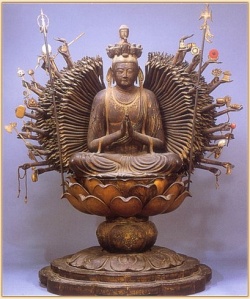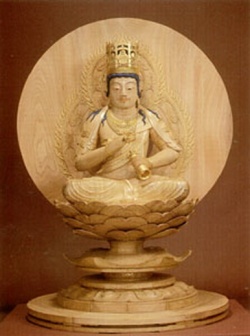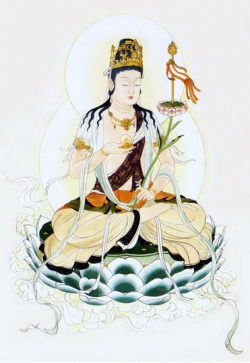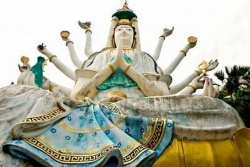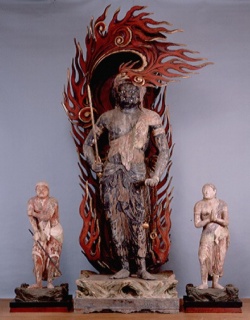Difference between revisions of "The Mantra Way"
(Created page with "thumb|250px| <poem> A Mantra, an Aspect of the Supreme Mantras are produced by combining alphabet sounds. Many syllables and further combinations of so...") |
|||
| (2 intermediate revisions by the same user not shown) | |||
| Line 1: | Line 1: | ||
[[File:Kattsaka.jpg|thumb|250px|]] | [[File:Kattsaka.jpg|thumb|250px|]] | ||
| + | |||
| + | |||
| + | |||
| + | |||
| + | |||
<poem> | <poem> | ||
| − | A Mantra, an Aspect of the Supreme | + | A [[Mantra]], an Aspect of the Supreme |
| − | Mantras are produced by combining alphabet sounds | + | [[Mantras]] are produced by [[combining]] [[alphabet]] {{Wiki|sounds}}. |
| − | + | Many {{Wiki|syllables}} and further combinations of {{Wiki|sounds}} may be produced, but according to [[mantra]] {{Wiki|theory}}, not all of them work very well for a [[human]]. | |
| − | + | For that [[reason]] many syllable-sounds are left out, and just a few sound-combinations of the total, possible number is adhered to. | |
| − | + | The [[art]] of [[mantras]] has it that if you do such intoning full well, nobody hears it but yourself, believe it or not. You may come to understand why as you read on. | |
| − | The white and supremely kind and blissful Kula-sundari (also called Sundari, Tripurasundari and Tripura) is said to be Beauty par excellence, makes all-knowing. She is one of several forms of the supreme power, according to the theory that says that secret impulses of God are the cause Creation itself. Very subtle impulses from the depths vibrate and become yonis (in their literal form: female organs) that are effulgent inner sources of manifestation. Some such Facets of God (Goddesses, raja mantras) are said to be auspicious, but others are said to be terrible. What about this?: "Beauty awakens love that binds the victims". | + | Some [[sound]] sets ([[mantras]]) tend to [[cause]] [[confusion]], others [[agitation]] and even havoc, and a few ones are said to bring tall benefits that include "Great [[Bliss]] as the creative [[Brahman]] ([[God]])" in [[Hindu]] {{Wiki|terminology}}. [Kuo 62] |
| + | |||
| + | [[Beauty]] | ||
| + | |||
| + | The white and supremely kind and [[blissful]] [[Kula-sundari]] (also called [[Sundari]], [[Tripurasundari]] and [[Tripura]]) is said to be [[Beauty]] par [[excellence]], makes all-knowing. | ||
| + | |||
| + | She is one of several [[forms]] of the supreme power, according to the {{Wiki|theory}} that says that secret {{Wiki|impulses}} of [[God]] are the [[cause]] Creation itself. | ||
| + | |||
| + | Very {{Wiki|subtle}} {{Wiki|impulses}} from the depths vibrate and become yonis (in their literal [[form]]: | ||
| + | |||
| + | {{Wiki|female}} {{Wiki|organs}}) that are effulgent inner sources of [[manifestation]]. | ||
| + | |||
| + | Some such Facets of [[God]] ([[Goddesses]], [[raja]] [[mantras]]) are said to be [[auspicious]], but others are said to be terrible. | ||
| + | |||
| + | What about this?: "[[Beauty]] awakens [[love]] that binds the {{Wiki|victims}}". | ||
[[File:Kongo-satta.jpg|thumb|250px|]] | [[File:Kongo-satta.jpg|thumb|250px|]] | ||
| − | Sundari, Beauty Itself, is a "supremely kind one", but seated on blood | + | [[Sundari]], [[Beauty]] Itself, is a "supremely kind one", but seated on {{Wiki|blood}}. |
| − | + | She has three [[eyes]] and four hands. | |
| − | + | She is a Mother (generatix) of [[Love]]. | |
| − | + | "[[Beauty]] easily evokes [[love]]," is a lesson found to lie implied in or even built into such artistic depictions and handed-over and more or less [[Wikipedia:canonical|canonical]] descriptions. | |
| − | + | Among the accessories in her hands is the noose of [[love]]. "[[Love]] serves to tie men," is another dear lesson. [[Love]] serves to bind a lot of willing {{Wiki|victims}}. | |
| − | Sound of Beauty | + | In her quiver are the five arrows that represent [[sound]], {{Wiki|touch}}, [[form]], relish, and {{Wiki|flavour}}. |
| + | |||
| + | Her {{Wiki|crown}} is studded with gorgeous [[gems]], and "on her beauteous breasts are [[clusters]] of [[red]] [[gems]]". | ||
| + | |||
| + | Her [[prayer beads]] (as if she needs them) are made of [[gems]], and she makes a gesture of explanation. | ||
| + | |||
| + | She is surrounded by [[beings]] who sing her praises. The [[colour red]] sourrounds her [Tata 49-53, passim] | ||
| + | |||
| + | |||
| + | She ought to be [[meditated]] on for {{Wiki|learning}}, [[wealth]], and [[beauty]], the teachings goes. If you seek [[wealth]], see her as golden. Some make drawings of her from such descriptions like these, according to handed-over [[directions]] [Ibid]. | ||
| + | |||
| + | As seen from the iconographic descriptions, woman is taken to represent the supreme power [Tata xviii]. | ||
| + | |||
| + | On the other hand, a concrete woman is not needed, but can be superceded [Tata xix]. Not all are willing to do that. | ||
| + | |||
| + | [[Sound]] of [[Beauty]] | ||
[[File:Ksitigarbhal;,j.jpg|thumb|250px|]] | [[File:Ksitigarbhal;,j.jpg|thumb|250px|]] | ||
| − | Benign mantras are sounds of power and fit for advancement in life. Sundari's mantra is held in very high esteem. Being full of cheer is a good sign, as Sundari is said to be the essence of good cheer too. Klim (Kling) is considered one of Her sound-bodies. A few other mantras are given too, but only "Kling" or "Klim" is studied here. It is known as yielding "a kind bliss", and as the "king of (lustful) love", kamaraja. It serves some during copulation - being united to a consort and growing full of cheer. | + | Benign [[mantras]] are {{Wiki|sounds}} of power and fit for advancement in [[life]]. |
| + | |||
| + | Sundari's [[mantra]] is held in very high esteem. | ||
| + | |||
| + | Being full of cheer is a good sign, as [[Sundari]] is said to be the [[essence]] of good cheer too. [[Klim]] (Kling) is considered one of Her sound-bodies. | ||
| + | |||
| + | A few other [[mantras]] are given too, but only "Kling" or "[[Klim]]" is studied here. It is known as yielding "a kind [[bliss]]", and as the "[[king]] of ([[lustful]]) [[love]]", [[kamaraja]]. It serves some during copulation - being united to a [[consort]] and growing full of cheer. | ||
| + | |||
| + | |||
| + | Some words from a Norwegian hymn serve other ends: "Kling no klokka, kling og lokka, kling og lokka . . . ([[Chime]] now, [[bell]], [[chime]] and allure, [[chime]] and allure . . .)" | ||
| + | |||
| + | One may [[wonder]] what the repetition of these {{Wiki|sounds}} do to a man if he gets [[obsessed]] with the first of them. | ||
| + | |||
| + | He says "kling" to himself so often and very guarded that no one hears him doing it, and then he is on the way to great [[love]], supposedly. | ||
| + | |||
| + | Can it be? Yes, affirms [[Tantra]]. | ||
| − | + | For [[Tantra]] teaches that the surface meanings of {{Wiki|sounds}} give way to their "depth-influence", or the aye-aye of the deep instigations themselves in the long run. | |
| − | + | That is a part of the teachings. | |
| − | Seed sounds, bijas | + | |
| + | In 'kling' the [[Sanskrit]] "ng" is the [[bindu]] [[sound]]. It can be said to be somewhere between 'ng' and 'm', and placed with a focus as high up in the {{Wiki|nose}} as you can get. | ||
| + | |||
| + | The [[sound]] is the last part of the [[OM]] (AUM) [[sound]] too [Ibid]. | ||
| + | |||
| + | Seed {{Wiki|sounds}}, [[bijas]] | ||
[[File:Kuan Yin2.jpg|thumb|250px|]] | [[File:Kuan Yin2.jpg|thumb|250px|]] | ||
| − | Speaking of mantras: They are syllables or sets of syllables. According to Tantra some sound are called seed sounds, bijas | + | {{Wiki|Speaking}} of [[mantras]]: They are {{Wiki|syllables}} or sets of {{Wiki|syllables}}. According to [[Tantra]] some [[sound]] are called seed {{Wiki|sounds}}, [[bijas]]. |
| − | The | + | The [[sound]] suited to "a kind [[bliss]]", [[Klim]] (Kling), is among them. |
| − | + | The [[initiate]] is made to know that there is an inward significance of the [[mantra]]. | |
| − | Such great gifts to many who are living in the world - also householders and housewives - can bring many benefits, depending on how beneficient the selected mantra or mantras are for each person. There is an art to the matching of mantra and mantra-users too. [Guru Dev's teachings] | + | The [[sound]] - when pronounced all right - is the gladdening [[form]] ([[sva-rupa]]) of the force that is symbollically shown as a {{Wiki|female}} through representative [[art]] with many [[symbolic]] items [[attached]]. |
| + | |||
| + | Thus, the [[teaching]] is that different [[powers]] are accessed through specificed [[mantras]], and that repeating a handed-over [[mantra]] brings [[attunement]] with that enfoldment, thatshakti. | ||
| + | |||
| + | |||
| + | The [[mantra]] may be represented by other means than [[sound]] too: | ||
| + | |||
| + | In [[Sanskrit]] letters and the like, by [[mystical]] diagrams ([[yantras]]); and a deified, humanoid picture - often with extra sets of arms and hands - is seen in some circles too [Tog, passim; Ebu "[[tantra]]"] | ||
| + | |||
| + | |||
| + | |||
| + | [[Attunement]] grows by steady repetition of the [[mantra]], and brings on more at-one-ment each time you sit down to "take off". | ||
| + | |||
| + | In the [[mantra way]] the "rune [[sound]]" ([[mantra]]) is said to be a [[form]] ([[rupa]]) of [[Brahman]] | ||
| + | |||
| + | (The Lord of All) [[manifesting]] in {{Wiki|sounds}} of the [[Sanskrit alphabet]] and other alphabets. | ||
| + | |||
| + | Note that according to some injunctions, the [[mantras]] are not to be said, not to be uttered, but are to be "placed in the [[heart]]" as you [[mentally]] repeat the carefully chosen and patently guarded set of letters (or {{Wiki|syllables}}). | ||
| + | |||
| + | They are not spoken but listened to - [[mentally]] repeated in carefully geared ways. | ||
| + | |||
| + | |||
| + | Such great gifts to many who are living in the [[world]] - also householders and housewives - can bring many benefits, depending on how beneficient the selected [[mantra]] or [[mantras]] are for each [[person]]. | ||
| + | |||
| + | There is an [[art]] to the matching of [[mantra]] and mantra-users too. [[[Guru]] Dev's teachings] | ||
[[File:Maki-fudo-2l.jpg|thumb|250px|]] | [[File:Maki-fudo-2l.jpg|thumb|250px|]] | ||
| − | |||
| − | During the practice it is well not to seek to analyse or imagine things during the mantra repetition. " Do not imagine . . . do not analyse . . . do not reflect," says the Indian master Tilopa from centuries ago. One can reach up to that. Otherwise, make no big deal of disturbing ideas and images that pop ut, but gently resume repeating the mantra as often as you get aware of these disturbances. [Ebu "Buddhism"] | + | Further, [[mentally]] intoning and repeating a [[mantra]] can be easily practised by a guileless, [[faithful]] [[heart]] after it has got "wed" to the most suitable [[mantra]] found. |
| + | |||
| + | Maybe a hundred uninterrupted repetitions "brings the pot to boil" inside you, but it does not have to end there: the [[bliss]] may also swell - a [[Divine]] embrace. [Cot 32-42] | ||
| + | |||
| + | During the practice it is well not to seek to analyse or [[imagine]] things during the [[mantra]] repetition. " | ||
| + | |||
| + | Do not [[imagine]] . . . do not analyse . . . do not reflect," says the [[Indian master]] [[Tilopa]] from centuries ago. One can reach up to that. | ||
| + | |||
| + | Otherwise, make no big deal of {{Wiki|disturbing}} [[ideas]] and images that pop ut, but gently resume repeating the [[mantra]] as often as you get {{Wiki|aware}} of these {{Wiki|disturbances}}. [Ebu "[[Buddhism]]"] | ||
| + | |||
| + | |||
| + | Now you can try it. | ||
| + | |||
| + | Note and adhere to all the {{Wiki|rules}} for attuning to and maybe [[attaining]] Great [[Happiness]] inside, so as not to get injured. | ||
| + | |||
| + | All specifications are not shown here. | ||
| − | + | If the [[mantra]] practice is not easy, something is the {{Wiki|matter}}. It should be easy. Take such goings serious, as a must. | |
| − | |||
| − | |||
| − | Nine gems are enumerated as valuable and fit more a lot more than adornment. They are cat's eye, sapphire, topaz, coral, pearl, emerald, diamond, and ruby [Tata 31]. These gems may enrich your life if you do not impoverish yourself to get all of them, especially emerald, diamond, and ruby, and they are all presently used in so-called Gem Therapy, by the way. | + | Phallos and [[Gems]] |
| + | |||
| + | |||
| + | The phallos ([[linga]]) is [[symbolic]] too. [[Sages]] (munis) may interpret it for you. There is a vast {{Wiki|literature}} to get into right there. | ||
| + | |||
| + | Nine [[gems]] are enumerated as valuable and fit more a lot more than adornment. | ||
| + | |||
| + | They are cat's [[eye]], {{Wiki|sapphire}}, topaz, [[coral]], {{Wiki|pearl}}, {{Wiki|emerald}}, [[diamond]], and {{Wiki|ruby}} [Tata 31]. | ||
| + | |||
| + | These [[gems]] may enrich your [[life]] if you do not impoverish yourself to get all of them, especially {{Wiki|emerald}}, [[diamond]], and {{Wiki|ruby}}, and they are all presently used in so-called [[Gem]] Therapy, by the way. | ||
[[File:Mysticbeatitudeas.jpg|thumb|250px|]] | [[File:Mysticbeatitudeas.jpg|thumb|250px|]] | ||
| − | |||
| − | Here we have been into glimpses of ancient Vedic teachings of Shabda-Brahman. As can be seen, some vital parts of the theory are in full use in Buddhist Tantra, also called Tibetan Buddhism. | + | Some enumerated [[rites]] are told to be conductive to [[knowledge]] of {{Wiki|past}}, {{Wiki|present}}, and {{Wiki|future}} [Tata 34]. |
| − | Poses Can Suit Great Awakening | + | |
| + | A [[principle]] is that [[mastery]] may [[cause]] [[wealth]], {{Wiki|learning}}, long [[life]], and what one [[desires]], also [[beauty]] [Tata 509; Ebu "[[Tantra]]"] | ||
| + | |||
| + | Here we have been into glimpses of [[ancient]] {{Wiki|Vedic}} teachings of [[Shabda-Brahman]]. | ||
| + | |||
| + | As can be seen, some [[vital]] parts of the {{Wiki|theory}} are in full use in [[Buddhist Tantra]], also called [[Tibetan Buddhism]]. Gas 37-38 | ||
| + | Poses Can Suit [[Great Awakening]] | ||
| − | |||
| − | |||
| − | + | [[Tantra]] teaches, as [[Buddha]], that man can be [[awakened]] to the [[Truth]] [Pakk 34]. | |
| − | Yogic tongue lifting, some points | + | In a [[posture]] fit for prolonged contemplation - lax yet able - keep the {{Wiki|breast}} forward somehow, and the shoulders a bit backward. |
| + | |||
| + | Choose closed or half-open [[eyes]] as you please. | ||
| + | |||
| + | A sitting is to be accomplished with as little strain and force as can be. [[Meditate]] as laxly as can be. It should be good and [[feel]] good. | ||
| + | |||
| + | |||
| + | To enlarge on that bit: Straighten the [[body]] and assume a comfortable sitting position, crossing the {{Wiki|legs}} if you can do that without strain and "ouch!" There are several cross-legged positions. | ||
| + | |||
| + | The comfortable "tailor's pose" may serve you well enough, at least the first twenty years. Focus on repeating your well-chosen, guarded [[mantra]]. | ||
| + | |||
| + | Place the hands level and equipoised below the {{Wiki|navel}} if you find it to be good. | ||
| + | |||
| + | [[Yogic]] {{Wiki|tongue}} lifting, some points | ||
[[File:Mzl.rpbuf.jpg|thumb|250px|]] | [[File:Mzl.rpbuf.jpg|thumb|250px|]] | ||
| − | You may be instructed to place the tongue upward against the roof of the mouth too, as you sit and try to meditate. I think it is up to you to let it be or comply. Besides, it can be good to allow for variations in such a practice too. | + | You may be instructed to place the {{Wiki|tongue}} upward against the roof of the {{Wiki|mouth}} too, as you sit and try to [[meditate]]. I think it is up to you to let it be or comply. |
| + | |||
| + | Besides, it can be good to allow for variations in such a practice too. | ||
| + | |||
| + | |||
| + | There are some cons to reckon with: [[Yogic]] {{Wiki|tongue}} lifting ([[kechari mudra]]) | ||
| + | |||
| + | |||
| + | (1) is no big deal; | ||
| + | (2) is hardly [[essential]]; | ||
| + | (3) may be unfeasible for many long years of self-torture or {{Wiki|training}} if you are called to lengthen your {{Wiki|tongue}} for it and be able to put your {{Wiki|tongue}} into the {{Wiki|nose}} cavity from the back side; (4) may have some effect, but hardly the Great Effect you are after. | ||
| + | |||
| + | Norman Paulsen succeeded in that last feat and concluded that it really was not necessary - [More] | ||
| + | |||
| + | |||
| + | To enlarge on the [[subject]] that [[Guru]] Dev and [[Maharishi]] do not tell are necessary either, as far as I know: | ||
| + | |||
| + | Satyananda says the {{Wiki|tongue}} should not be placed against the roof of the {{Wiki|mouth}}, but be turned upward so that the tip reaches the inner nostril openings and then plugs them (!). | ||
| + | |||
| − | + | And that is the [[kechari mudra]]. | |
| + | |||
| + | |||
| + | It is claimed to [[cause]] a [[calm]] [[state]], but most often not for the beginner; he is adviced not to use it by Satyananda. | ||
| + | |||
| + | First the {{Wiki|tongue}} has to be trained, and, in most cases, gradually lengthened by massaging and stretching it. | ||
| + | |||
| + | Little by, over a period of months or years, the {{Wiki|tongue}} lengthening that is not actually needed, is had. | ||
| + | |||
| + | Norman Paulsen succeeded in it, discarded it, and most likely a long {{Wiki|tongue}} remained. | ||
| − | |||
Otherwise | Otherwise | ||
| − | If you | + | If you reg |
| + | ulate your living so that you incorporate suggestions like the ones above in reasonable, sensible ways that fit you, | ||
| + | |||
| + | you are close to what [[Dogen]] means by saying "To practice [[Zazen]] [[[Zen]] sitting] is the whole of [[Buddhism]], and [[Buddhism]] is just the practice of [[Zazen]]," according to Rev. [[Gudo Nishijima]] of [[Soto Zen]]. | ||
| + | |||
| + | |||
| + | By getting fit for everyday [[life]] you may gain more control over your circumstance and may get rid of many annoyances and {{Wiki|disturbances}} that hardly help a [[heart]] on the way upwards or inwards. | ||
| − | + | It matters to gain freedom to have deep and outward [[silence]]. | |
| + | |||
| + | Also, [[pleasant]] [[music]] may be another boon, along with getting rid of {{Wiki|disturbances}}, nuisances and very unwelcome, harassing guests. | ||
| + | |||
| + | |||
| + | In addition, fair and fit [[Vipassana]] [[Meditation]] [qv] could help {{Wiki|abilities}} to observe what is going on on and up too, and [[benefit]] your [[life]] too. | ||
| + | |||
| + | You won't know how if you don't try. [[Vipassana]] aims at gaining clear [[insight]], wisely developed, and in part dependent on skills. Let [[mental]] ease and great [[calmness]] assist your towering [[insights]]. | ||
| + | |||
| + | Access to [[insight]] through contemplation is a good deal. | ||
| + | |||
| + | Ebu "[[Buddhism]]"; [[Somdet Phra]] Buddhaghosacariya, comp. [[Uposatha]] [[Sila]]. 2nd ed. 1993] | ||
| − | |||
Granted gift-waves | Granted gift-waves | ||
| − | Mind, too, the "thing" called "gift-waves" of grace flowing from deep within. Such elements go into Mahayana teachings of Yoga and lie at the bottom of many lines of transmission. Evens-Wentz writes the gift-waves are waves of psychic energy which stimulate spiritual development and greatly assist the aspirant seeking Nirvanic Enlightenment, the highest boon on earth. These 'gift-waves' are sent forth by Gurus, and some of them can be "in the superhuman realms." The granting of these 'gift-waves', otherwise known as the 'conferring of power', constitutes the true spiritual initiation. [Tiy 123, 123n] | + | [[Mind]], too, the "thing" called "gift-waves" of grace flowing from deep within. |
| + | |||
| + | Such [[elements]] go into [[Mahayana teachings]] of [[Yoga]] and lie at the bottom of many lines of [[transmission]]. | ||
| + | |||
| + | [[Evens-Wentz]] writes the gift-waves are waves of [[psychic energy]] which stimulate [[spiritual development]] and greatly assist the aspirant seeking [[Nirvanic]] [[Enlightenment]], the [[highest]] boon on [[earth]]. | ||
| + | |||
| + | These 'gift-waves' are sent forth by [[Gurus]], and some of them can be "in the superhuman [[realms]]." | ||
| + | |||
| + | The granting of these 'gift-waves', otherwise known as the 'conferring of power', constitutes the true [[spiritual]] [[initiation]]. [Tiy 123, 123n] | ||
Getting stuck in great-sounding words means stuck | Getting stuck in great-sounding words means stuck | ||
| − | The wisdom of minding yourself full well is well-nigh indescribable. However, keep your mind intact and natural, and heed its symbols too. That is a very significant part of Tilopa's dear teachings. Great Bliss is from the Primordial Abode. [Tiy 150, 200] | + | The [[wisdom]] of [[minding]] yourself full well is well-nigh [[indescribable]]. |
| + | |||
| + | However, keep your [[mind]] intact and natural, and heed its [[symbols]] too. | ||
| + | |||
| + | That is a very significant part of [[Tilopa's]] dear teachings. | ||
| + | |||
| + | Great [[Bliss]] is from the [[Primordial]] Abode. [Tiy 150, 200] | ||
| + | |||
| + | One more far too overlooked [[teaching]] seems to be: "Regard not the [[Void]] as being [[Nothingness]]", for It is "Thatness, the Norm of Being, the [[Cause]]", says {{Wiki|W. Y. Evans-Wentz}}. | ||
| − | + | "The unenlightened alone regard It as being [[nothingness]]." Lesson: It should work best to drop misleading lingo from the onset. [Tiy 117-22, passim | |
</poem> | </poem> | ||
{{R}} | {{R}} | ||
[http://oaks.nvg.org/mantrayana-words.html oaks.nvg.org] | [http://oaks.nvg.org/mantrayana-words.html oaks.nvg.org] | ||
[[Category:Mantrayana]] | [[Category:Mantrayana]] | ||
| + | [[Category:Buddhist Terms]] | ||
Latest revision as of 20:34, 30 November 2023
A Mantra, an Aspect of the Supreme
Mantras are produced by combining alphabet sounds.
Many syllables and further combinations of sounds may be produced, but according to mantra theory, not all of them work very well for a human.
For that reason many syllable-sounds are left out, and just a few sound-combinations of the total, possible number is adhered to.
The art of mantras has it that if you do such intoning full well, nobody hears it but yourself, believe it or not. You may come to understand why as you read on.
Some sound sets (mantras) tend to cause confusion, others agitation and even havoc, and a few ones are said to bring tall benefits that include "Great Bliss as the creative Brahman (God)" in Hindu terminology. [Kuo 62]
Beauty
The white and supremely kind and blissful Kula-sundari (also called Sundari, Tripurasundari and Tripura) is said to be Beauty par excellence, makes all-knowing.
She is one of several forms of the supreme power, according to the theory that says that secret impulses of God are the cause Creation itself.
Very subtle impulses from the depths vibrate and become yonis (in their literal form:
female organs) that are effulgent inner sources of manifestation.
Some such Facets of God (Goddesses, raja mantras) are said to be auspicious, but others are said to be terrible.
What about this?: "Beauty awakens love that binds the victims".
Sundari, Beauty Itself, is a "supremely kind one", but seated on blood.
She has three eyes and four hands.
She is a Mother (generatix) of Love.
"Beauty easily evokes love," is a lesson found to lie implied in or even built into such artistic depictions and handed-over and more or less canonical descriptions.
Among the accessories in her hands is the noose of love. "Love serves to tie men," is another dear lesson. Love serves to bind a lot of willing victims.
In her quiver are the five arrows that represent sound, touch, form, relish, and flavour.
Her crown is studded with gorgeous gems, and "on her beauteous breasts are clusters of red gems".
Her prayer beads (as if she needs them) are made of gems, and she makes a gesture of explanation.
She is surrounded by beings who sing her praises. The colour red sourrounds her [Tata 49-53, passim]
She ought to be meditated on for learning, wealth, and beauty, the teachings goes. If you seek wealth, see her as golden. Some make drawings of her from such descriptions like these, according to handed-over directions [Ibid].
As seen from the iconographic descriptions, woman is taken to represent the supreme power [Tata xviii].
On the other hand, a concrete woman is not needed, but can be superceded [Tata xix]. Not all are willing to do that.
Sound of Beauty
Benign mantras are sounds of power and fit for advancement in life.
Sundari's mantra is held in very high esteem.
Being full of cheer is a good sign, as Sundari is said to be the essence of good cheer too. Klim (Kling) is considered one of Her sound-bodies.
A few other mantras are given too, but only "Kling" or "Klim" is studied here. It is known as yielding "a kind bliss", and as the "king of (lustful) love", kamaraja. It serves some during copulation - being united to a consort and growing full of cheer.
Some words from a Norwegian hymn serve other ends: "Kling no klokka, kling og lokka, kling og lokka . . . (Chime now, bell, chime and allure, chime and allure . . .)"
One may wonder what the repetition of these sounds do to a man if he gets obsessed with the first of them.
He says "kling" to himself so often and very guarded that no one hears him doing it, and then he is on the way to great love, supposedly.
Can it be? Yes, affirms Tantra.
For Tantra teaches that the surface meanings of sounds give way to their "depth-influence", or the aye-aye of the deep instigations themselves in the long run.
That is a part of the teachings.
In 'kling' the Sanskrit "ng" is the bindu sound. It can be said to be somewhere between 'ng' and 'm', and placed with a focus as high up in the nose as you can get.
The sound is the last part of the OM (AUM) sound too [Ibid].
Seed sounds, bijas
Speaking of mantras: They are syllables or sets of syllables. According to Tantra some sound are called seed sounds, bijas.
The sound suited to "a kind bliss", Klim (Kling), is among them.
The initiate is made to know that there is an inward significance of the mantra.
The sound - when pronounced all right - is the gladdening form (sva-rupa) of the force that is symbollically shown as a female through representative art with many symbolic items attached.
Thus, the teaching is that different powers are accessed through specificed mantras, and that repeating a handed-over mantra brings attunement with that enfoldment, thatshakti.
The mantra may be represented by other means than sound too:
In Sanskrit letters and the like, by mystical diagrams (yantras); and a deified, humanoid picture - often with extra sets of arms and hands - is seen in some circles too [Tog, passim; Ebu "tantra"]
Attunement grows by steady repetition of the mantra, and brings on more at-one-ment each time you sit down to "take off".
In the mantra way the "rune sound" (mantra) is said to be a form (rupa) of Brahman
(The Lord of All) manifesting in sounds of the Sanskrit alphabet and other alphabets.
Note that according to some injunctions, the mantras are not to be said, not to be uttered, but are to be "placed in the heart" as you mentally repeat the carefully chosen and patently guarded set of letters (or syllables).
They are not spoken but listened to - mentally repeated in carefully geared ways.
Such great gifts to many who are living in the world - also householders and housewives - can bring many benefits, depending on how beneficient the selected mantra or mantras are for each person.
There is an art to the matching of mantra and mantra-users too. [[[Guru]] Dev's teachings]
Further, mentally intoning and repeating a mantra can be easily practised by a guileless, faithful heart after it has got "wed" to the most suitable mantra found.
Maybe a hundred uninterrupted repetitions "brings the pot to boil" inside you, but it does not have to end there: the bliss may also swell - a Divine embrace. [Cot 32-42]
During the practice it is well not to seek to analyse or imagine things during the mantra repetition. "
Do not imagine . . . do not analyse . . . do not reflect," says the Indian master Tilopa from centuries ago. One can reach up to that.
Otherwise, make no big deal of disturbing ideas and images that pop ut, but gently resume repeating the mantra as often as you get aware of these disturbances. [Ebu "Buddhism"]
Now you can try it.
Note and adhere to all the rules for attuning to and maybe attaining Great Happiness inside, so as not to get injured.
All specifications are not shown here.
If the mantra practice is not easy, something is the matter. It should be easy. Take such goings serious, as a must.
Phallos and Gems
The phallos (linga) is symbolic too. Sages (munis) may interpret it for you. There is a vast literature to get into right there.
Nine gems are enumerated as valuable and fit more a lot more than adornment.
They are cat's eye, sapphire, topaz, coral, pearl, emerald, diamond, and ruby [Tata 31].
These gems may enrich your life if you do not impoverish yourself to get all of them, especially emerald, diamond, and ruby, and they are all presently used in so-called Gem Therapy, by the way.
Some enumerated rites are told to be conductive to knowledge of past, present, and future [Tata 34].
A principle is that mastery may cause wealth, learning, long life, and what one desires, also beauty [Tata 509; Ebu "Tantra"]
Here we have been into glimpses of ancient Vedic teachings of Shabda-Brahman.
As can be seen, some vital parts of the theory are in full use in Buddhist Tantra, also called Tibetan Buddhism. Gas 37-38
Poses Can Suit Great Awakening
Tantra teaches, as Buddha, that man can be awakened to the Truth [Pakk 34].
In a posture fit for prolonged contemplation - lax yet able - keep the breast forward somehow, and the shoulders a bit backward.
Choose closed or half-open eyes as you please.
A sitting is to be accomplished with as little strain and force as can be. Meditate as laxly as can be. It should be good and feel good.
To enlarge on that bit: Straighten the body and assume a comfortable sitting position, crossing the legs if you can do that without strain and "ouch!" There are several cross-legged positions.
The comfortable "tailor's pose" may serve you well enough, at least the first twenty years. Focus on repeating your well-chosen, guarded mantra.
Place the hands level and equipoised below the navel if you find it to be good.
Yogic tongue lifting, some points
You may be instructed to place the tongue upward against the roof of the mouth too, as you sit and try to meditate. I think it is up to you to let it be or comply.
Besides, it can be good to allow for variations in such a practice too.
There are some cons to reckon with: Yogic tongue lifting (kechari mudra)
(1) is no big deal;
(2) is hardly essential;
(3) may be unfeasible for many long years of self-torture or training if you are called to lengthen your tongue for it and be able to put your tongue into the nose cavity from the back side; (4) may have some effect, but hardly the Great Effect you are after.
Norman Paulsen succeeded in that last feat and concluded that it really was not necessary - [More]
To enlarge on the subject that Guru Dev and Maharishi do not tell are necessary either, as far as I know:
Satyananda says the tongue should not be placed against the roof of the mouth, but be turned upward so that the tip reaches the inner nostril openings and then plugs them (!).
And that is the kechari mudra.
It is claimed to cause a calm state, but most often not for the beginner; he is adviced not to use it by Satyananda.
First the tongue has to be trained, and, in most cases, gradually lengthened by massaging and stretching it.
Little by, over a period of months or years, the tongue lengthening that is not actually needed, is had.
Norman Paulsen succeeded in it, discarded it, and most likely a long tongue remained.
Otherwise
If you reg
ulate your living so that you incorporate suggestions like the ones above in reasonable, sensible ways that fit you,
you are close to what Dogen means by saying "To practice Zazen [[[Zen]] sitting] is the whole of Buddhism, and Buddhism is just the practice of Zazen," according to Rev. Gudo Nishijima of Soto Zen.
By getting fit for everyday life you may gain more control over your circumstance and may get rid of many annoyances and disturbances that hardly help a heart on the way upwards or inwards.
It matters to gain freedom to have deep and outward silence.
Also, pleasant music may be another boon, along with getting rid of disturbances, nuisances and very unwelcome, harassing guests.
In addition, fair and fit Vipassana Meditation [qv] could help abilities to observe what is going on on and up too, and benefit your life too.
You won't know how if you don't try. Vipassana aims at gaining clear insight, wisely developed, and in part dependent on skills. Let mental ease and great calmness assist your towering insights.
Access to insight through contemplation is a good deal.
Ebu "Buddhism"; Somdet Phra Buddhaghosacariya, comp. Uposatha Sila. 2nd ed. 1993]
Granted gift-waves
Mind, too, the "thing" called "gift-waves" of grace flowing from deep within.
Such elements go into Mahayana teachings of Yoga and lie at the bottom of many lines of transmission.
Evens-Wentz writes the gift-waves are waves of psychic energy which stimulate spiritual development and greatly assist the aspirant seeking Nirvanic Enlightenment, the highest boon on earth.
These 'gift-waves' are sent forth by Gurus, and some of them can be "in the superhuman realms."
The granting of these 'gift-waves', otherwise known as the 'conferring of power', constitutes the true spiritual initiation. [Tiy 123, 123n]
Getting stuck in great-sounding words means stuck
The wisdom of minding yourself full well is well-nigh indescribable.
However, keep your mind intact and natural, and heed its symbols too.
That is a very significant part of Tilopa's dear teachings.
Great Bliss is from the Primordial Abode. [Tiy 150, 200]
One more far too overlooked teaching seems to be: "Regard not the Void as being Nothingness", for It is "Thatness, the Norm of Being, the Cause", says W. Y. Evans-Wentz.
"The unenlightened alone regard It as being nothingness." Lesson: It should work best to drop misleading lingo from the onset. [Tiy 117-22, passim
